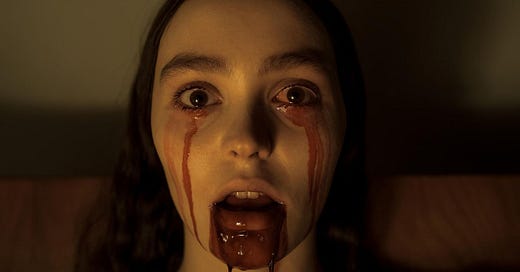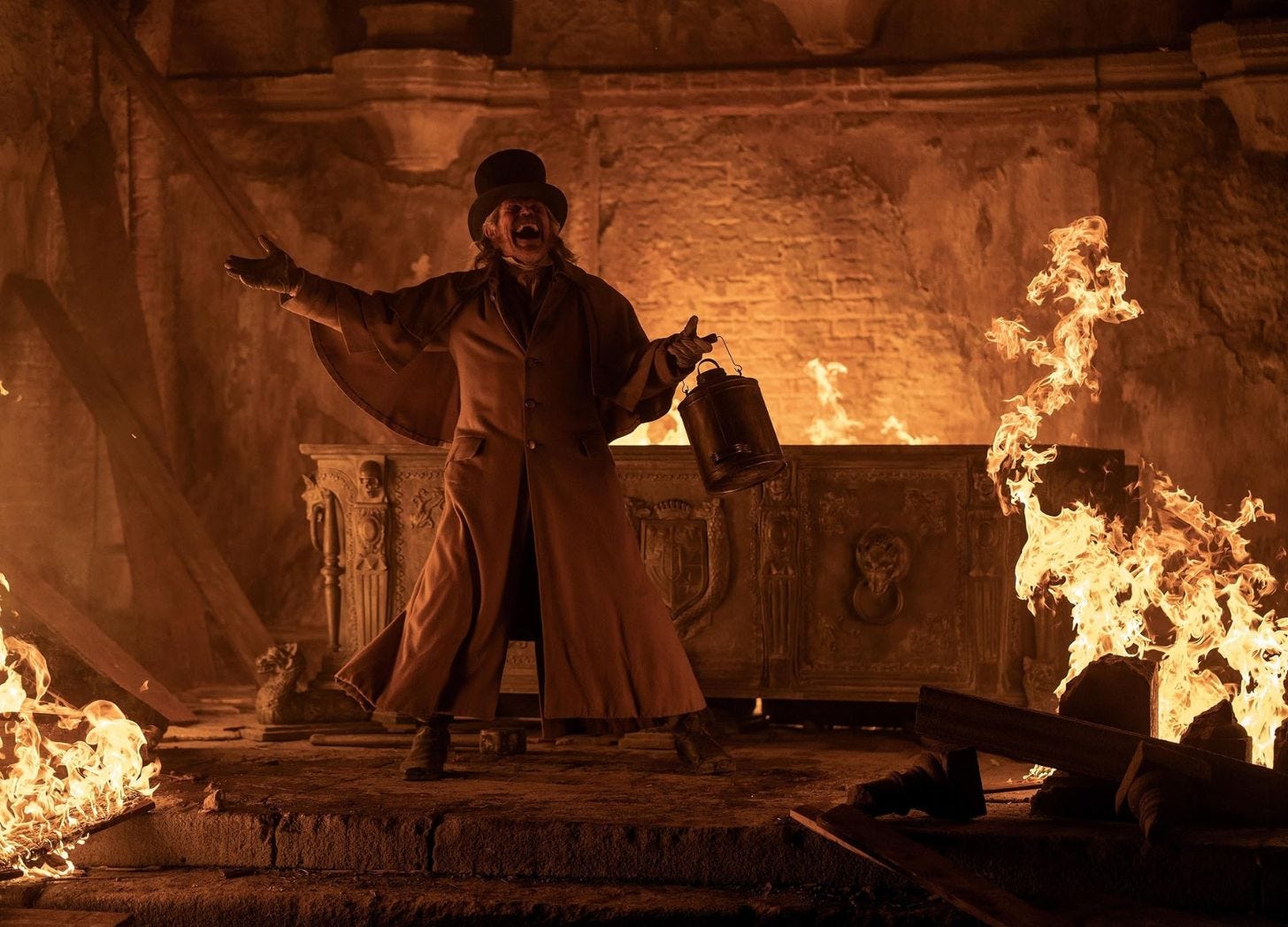New Life for Nosferatu
How a Subtle Change to Ellen's Backstory Adds New Potential to an Old Classic
If you’re new here, read this quick primer on the Story Energies, a new way to talk about storytelling.
Dracula is a story, obviously. You’ve probably read or seen it several times, in some combination of the original novel and a handful of fairly faithful movie adaptations. And then there are all the various spinoffs and franchises that bear little resemblance to the original plot, but feature the Count and some of his trappings (the cloak; the fangs; aversions to garlic and crucifixes; a stiff posture), and build on what has become a sweeping, sprawling legend.
This legendary status is something of a double-pointed fang for someone like Robert Eggers, who wrote and directed the most recent Nosferatu (which I saw last week1). Audiences will recognise it and so are more likely to buy tickets, and it must feel good to join a pantheon that already includes Bram Stoker, F. W. Murnau, Werner Herzog and Francis Ford Coppola. But along with the responsibility to do your predecessors justice, you also have to try to strike terror into the hearts of your audience with a story that a lot of them already know by heart.
For me, the first half of the film dragged a little—it was certainly engaging, and stylish, but it was also long, and as that real estate agent endured his nightmare at that old Transylvanian castle, I mostly felt like I knew more or less what was going to happen. Once the focus of the story returns to London the fictional German town of Wisborg, though, a freshness that was planted in the film’s prologue begins to permeate the action. This relatively subtle alteration—a new backstory for one of the relatively minor characters from the original—makes all sorts of differences to the story, and by the end I was perhaps confused, maybe a little disconcerted and perplexed, but I certainly wasn’t bored.
[Beware: spoilers lurking below.]
The first Nosferatu film (the German silent movie, A Symphony of Horror) made some alterations to Stoker’s original story. The London scenes were moved to Germany, most of the names were changed, and sunlight became fatal to vampires, not just enfeebling. Whereas Dracula was a former warlord who died in battle and returned as a vampire, Count Orlok was created by one of Satan’s lieutenants, and so embodied a purer evil, if that makes sense—even less worldly, even more supernatural. And while Jonathan Harker’s fiancée Mina gets to live happily after the men kill Dracula, Thomas Hutton’s wife Ellen distracts Orlok with her beauty and blood until he is surprised by the dawn. And so this “pure-hearted woman” sacrifices herself to slay the vampire and save her city.
The 2024 version builds on those changes by imbuing Ellen with her own supernatural glow. That prologue opens the story years earlier, as a younger Ellen yearns for the arrival of a mystical being, walks in her nightdress out into the garden, and awakens a presence—Count Orlok—who conscripts her into an eternal bond. We learn, then, that when she falls for Thomas, her love is powerful enough to subdue her mysterious cravings, and she can live a normal life with her betrothed. But the Count wants her back, and so he buys an old house outside her town, summons Thomas to his castle, then ships himself to Wisborg to reclaim what he considers rightfully his.
As the film builds towards its climax, this change to Ellen’s character—this additional charge of Potential Energy—impacts more or less every scene.
It adds layers of disconcerting depth to her relationships with the other characters—her friendship with Lucy Anna, her antagonism with Anna’s husband Friedrich, her alliance with Van Helsing Von Franz, and, especially, her romance with Thomas. And she herself becomes a compelling, consuming presence—not just beautiful and pure, but somehow simultaneously beatific and bestial.
Most of all, it’s her relationship with Count Orlak that rises to dominate the story. She isn’t just a victim who manages to overcome overwhelming odds, a David popping a Hail Mary shot at Goliath, but an unearthly counterpart to Orlak, a worthy adversary. Her attraction to him is not merely a symptom of a spell he’s cast over her, it’s a thick-blooded mix of hatred and lust. And their climactic consummation is no simple triumph of good over evil, but something much more complex and uncanny; awful in the conventional sense of being shocking and horrific, and also the archaic sense, of inspiring a reverential fear or wonder.
Most horror stories gain their power from a mix of Electric and Elastic Energies.
Electric in the atmosphere that haunts the scenes, and in the emotion—the fear!—that torments the characters.
And Elastic in the tension as the characters are threatened by violence, of one form or another, before they ultimately triumph (or meet their mutilating fates).
These Energies arise from the Potential Energy present in the story from the beginning, or introduced as it proceeds—the malevolent appetites of Count Dracula, for example, or the innocence and virtue of Jonathan Harker and Mina, as well as their ‘vices’, their pride and sexual proclivity.
2024’s Nosferatu’s transformation of Ellen’s character, from ‘pure maiden’ to ‘pure maiden with latent supernatural complications’ brings about profound changes to the story, even as the sequence of events remains quite similar to the 1922 version. Friedrich’s desire to rationalise what’s happening, and assert a paternalistic control over the women in his house, leads him to strap Ellen to her bed, and become her enemy. Thomas’s resolve to protect Ellen, upon his return from Transylvania, becomes comical, given her power and knowledge, and his cluelessness. So the young men are relegated from the heroes of the original novel to hapless, misguided, ultimately inconsequential fools.
And once Von Franz realises that Ellen is not simply an innocent child in need of protection, he can begin to really enjoy himself.
These changes drain some of that tension and emotion—that Elastic and Electrical Energy—from some of the film’s climactic scenes. Instead, the story draws upon a surge of Magnetic Energy generated by the bond between Orlok and Ellen. Unlike most horror-movie villain-heroine bonds, which are basically straightforward, this connection between these two supernatural forces is a heady mix of attraction and repulsion—loyal readers of this Substack will understand what I mean when I say it’s less Nobody Wants This, more Intermezzo. This helps produce a cinematic moment that I’m not sure I enjoyed, exactly, but that I’m sure I’ll remember for a long, long time.
In 1966, Jean Rhys’s novel Wide Sargasso Sea took a famous story, Jane Eyre, and imagined a prequel to Brontë’s novel told from the point of view of Mr. Rochester’s Creole wife, Antoinette Cosway. Since then, lots and lots of old stories have been revisited or reimagined by placing a minor character at the heart of the narrative. Jane Smiley’s A Thousand Acres retells the King Lear story, but set in the American heartland and told from the the point of view of Lear’s daughter Goneril (Ginny). Emma Cline’s The Girls offers a new perspective on the Manson murders, Madeline Miller’s Circe updates The Odyssey, Percival Everett’s James revisits Huckleberry Finn…
Robert Eggers’s Nosferatu is a less emphatic revision than any of these novels. And while it does make a supporting female character more significant, and give her more agency, I’m not sure that we can count it as a particularly feminist retelling—in that I’m not sure the best way to take down the patriarchy is to sacrifice yourself by lying back in bed and giving it what it wants.
Still, his version does give new life to the story by granting a fairly powerless character more strength, more control, more importance—by making her more interesting.
With that in mind, here’s a writing exercise for you to play with:
Take an existing story—a draft you are working on, or one you’ve completed, or one written by somebody else.
Choose a minor character who doesn’t have much power in the story.
Identify a challenge that character is facing, or a force that is impeding their freedom.
Begin a new story—or a new version of the existing story—where that character attempts to overcome that challenge or impeding force.
If you try this, let me know how you get on in the comments! Or share your own take on Nosferatu…
One of the advantages of spending the holidays with one’s in-laws: opportunities to go out and leave the kids at home.












